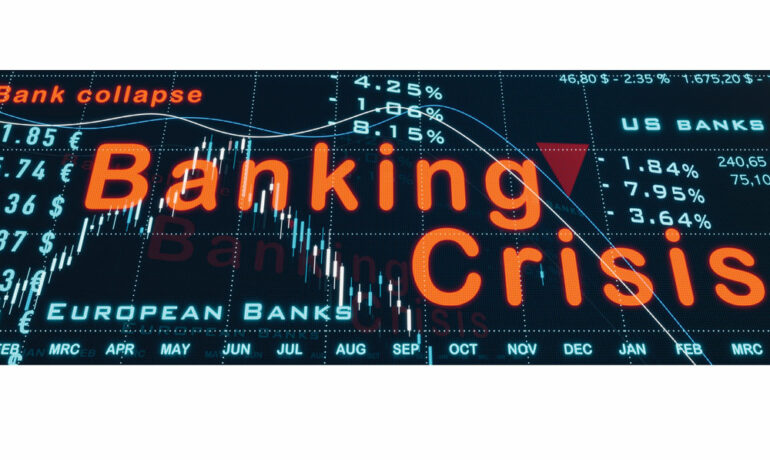The S&P 500 Index returned 7.50% and the S&P Global Broad Market Index returned 6.94% in the quarter ended March 31, 2023.1
Though you wouldn’t know it from the numbers just cited, the global stock market was full of drama last quarter, especially in the banking sector. First, in early March, Silicon Valley Bank (“SVB”) experienced one of the fastest deposit runs in history, resulting in its bankruptcy a mere 48 hours after the run started.2 As happens with bank runs, this contagious chain-of-events frightened depositors at many other banks around the country, leading to deposit flight from these banks and eventually to multiple government actions aimed at calming depositors.
Banking Crisis and How it Affects Brokerage Accounts
To understand what happened and why, let’s first run through how banks work. Broadly speaking, banks make money in two ways. One way they make money is by charging people and businesses fees for the various services they provide, including underwriting, advisory, payment processing, and so on. The second and, in many cases, the main way they make money is by taking in cash in the form of deposits from people and businesses and then turning around and either lending this money out or buying securities with it. In most economic environments, banks earn more in interest on the loans they’ve made and securities they’ve bought than they end up having to pay out to depositors, yielding a positive net interest income. However, unlike depositors, who, under most circumstances, are essentially guaranteed to get their money back whenever they want, the banks are taking two types of risk that can occasionally blow up in their faces.
The first risk is credit risk or the risk they won’t get paid back. This risk surfaced most memorably in 2008 when many banks realized, too late, that they had lent money or bought securities backed by mortgages that, because of the housing bubble, were going to be severely impaired. This awakening from the mass delusion that home prices only go up led to numerous bank runs, big jumps in unemployment, massive fiscal and monetary stimulus, and a narrow escape from a second Great Depression.
The second risk that banks take is duration risk or the risk that interest rates rise after they’ve made loans or bought securities. In other words, if a bank locks up most of its money in 10-year U.S. Treasury bonds at 2% and then short-term interest rates rise to 5%, the bank is likely to find itself upside-down in short order. First, this is because, if enough depositors want their money back, and the bank doesn’t want to spook investors by raising new capital, then the bank will need to sell its securities earning 2% to fund depositor withdrawals. This is problematic because when interest rates go up, nobody wants securities at 2% when they can invest elsewhere at 5%. So, in order to entice someone to buy 2% securities, the market price must drop until it effectively allows a new buyer to achieve 5% by purchasing it at a discount, resulting in large losses that eat into the bank’s equity. Some might think, “If only rules were relaxed and the bank weren’t forced to sell those 2% securities, then it could continue to own them until maturity and avoid realizing any paper losses.” However, the problem the bank now faces in this scenario is that depositors can move their money at any time and, with the ability to earn 5% in high-quality Treasuries or money market funds, many will decide to do so unless the bank offers high enough interest rates on deposits to retain them. If enough depositors force the bank’s hand and short-term interest rates stay high for long enough, the bank’s cost of funding will end up being higher than the 2% it earns on its securities, bankrupting the bank. In other words, these large unrealized paper losses on the 2% securities are essentially a forecast of the loss that the bank is going to incur if they hold these investments to maturity while deposit costs rise. This dynamic caused many banks to fail during the persistent inflation of the 1970s and 1980s, and it’s one of the main reasons Silicon Valley Bank failed as well. The conditions today were ripe for duration-mismatch problems after having gone through an economic period of “easy money” with deposits galore. With interest rates so low, the banks had to put the money to work somewhere, and many banks opted to reach for yield in long dated securities, creating this duration mismatch risk.
However, in an example of history never repeating but often rhyming, Silicon Valley Bank’s downfall was also idiosyncratically of today. Earlier, we mentioned that depositors, under most circumstances, are guaranteed to get their money back. However, there is an exception to this rule. The government only guarantees bank deposits up to $250,000. Above this level, depositors are potentially at risk of loss if a bank is mismanaged enough. In the case of SVB many of their customers were cash-draining start-up businesses who no longer had access to easy money to stop their cash burn as interest rates climbed. As these businesses used their deposits to plug the hole, as explained above, SVB would be required to sell securities at a loss or raise capital to fund the withdrawals. Additionally, SVB was the preferred bank of many of the tech elite for both their personal and corporate cash, and a large percentage of the depositors had far more than $250,000 in cash in the bank. As a result, when SVB went to raise cash to deal with the solvency issues it had brought on itself by buying too many long-dated securities at 2% interest rates with its depositor’s money, a few depositors realized the risk they were running if the capital raise failed. Because the tech community is so small and interconnected, the actions and warnings of these few quickly spread to their whole network of friends and colleagues, many of whom also banked at SVB. Furthermore, with online banking technology having taken off, the speed and ease with which one can move money from one bank to another has never been greater. This combination of factors led to an astounding 25%3 of SVB’s deposits disappearing in a mere 48 hours, forcing the FDIC to close the bank and stop the bleeding.
Of course, Silicon Valley Bank was not the only bank that was surprised by the speed of Fed hikes nor was it the only bank with a significant percentage of uninsured depositors. So, as news of Silicon Valley Bank spread, customers with greater than $250,000 on deposit started pulling cash from any bank not part of the group of 29 large international banks that regulators have deemed systemically important banks or, essentially, “too big to fail.” This deposit flight led to varying degrees of bank runs and liquidity crises at the thousands of smaller banks in the U.S., forcing the government to step in and guarantee the uninsured deposits of SVB and another bank that failed shortly thereafter, a New York-based regional bank named Signature Bank. Additionally, though the government didn’t explicitly guarantee uninsured deposits for all banks, it did provide additional funding to banks so that they won’t be forced to sell any of their high-quality securities trading at losses in order to meet liquidity needs. While these actions appear to have slowed bank runs, the highly publicized Silicon Valley Bank episode has set in motion a reassessment by many people and institutions of their cash holdings, leading many to diversify their deposit holdings and to move their deposits into higher-earning money market funds or Treasury bills. These actions, combined with the near certainty that new regulations are likely in the works that will require more capital and liquidity to be held by banks, mean many banks will have permanently impaired earnings power going forward. Additionally, if inflation stays elevated, we could have more bank failures as the math of 5% or higher interest rates and 2% long-duration loans and securities erodes the capital of some banking institutions. However, if this scenario were to occur, it’s not necessarily bad for the economy. As March economic data has so far demonstrated, bank failures from duration mismatches caused by too much inflation often don’t have the same paralyzing effect on the economy as credit crises. This difference occurs because of how bank lending works. When banks increase their lending, they increase the supply of money in the economy, which is inflationary. When they decrease their lending, they decrease the supply of money, which is deflationary. Therefore, banking problems, which cause banks to pull back on their lending in order to shore up their liquidity and capital, provide a deflationary counterweight to an economy with too much inflation. However, it could eventually become problematic if rates continue to quickly climb higher. In this scenario, deposits would keep flowing out of banks to pay for inflated goods, and there would be more cash sorting in search of the highest rates. This would create further losses at banks and further reduce their ability to lend, restricting credit and growth. Eventually, this would likely lead to a recession where credit problems would also begin to surface, which would likely add too much deflationary fuel to the fire.
Now that we’ve discussed the current banking backdrop, the next obvious question is, “If my brokerage fails, are my cash and securities that YCG manages safe?” And the short answer, in our opinion, is “Yes.” The first and most important reason for this is that you own the securities in your account and they are, therefore, required to be segregated from the other activities of the bank or brokerage where your money is housed. In other words, unlike deposits, which banks can use to make loans or buy securities, the banks and brokerages are not allowed to use your securities as collateral for loans or purchases of securities. This includes cash, unless you have an agreement with your brokerage to sweep the cash into affiliated bank accounts. However, even in this case, as long as you are below the $250,000 limit on cash per bank, the government guarantees that money. And, in some cases, the brokerage will sweep the cash into multiple affiliated banks to make sure all the money is protected by the U.S. government’s deposit guarantee. Second, regulators regularly examine all the banks, making sure they are adhering to the rules regarding brokerage segregation. Third, brokerage accounts are insured up to $500,000 (including up to $250,000 in cash) by the Securities Investor Protection Corporation (SIPC), a federally mandated, non-profit, member-funded corporation that all the big brokerages are required to join and fund. Fourth, many big brokerage firms buy additional private insurance that further protects their clients’ brokerage accounts. Lastly, given the size of the large brokerage firms, with many managing trillions of dollars of investor money, we believe the government likely views these entities as too big to fail and therefore would take steps to prevent them from going bankrupt, probably through a combination of dilutive capital injections, facilitations of mergers, and liquidity backstops. In summary, we believe your brokerage is unlikely to fail and that, even if it does, your account is highly likely to be fully intact and eventually available to move to another brokerage.
Concluding Thoughts
While headline stock market performance numbers suggest a tranquil first three months of the year, the first quarter was anything but calm. In March, a rolling bank run began that resulted in two bank failures, large price declines in many other regional banks, and multiple government backstops to restore confidence. Unlike in 2008, when the main reason for banking trouble was bad credit decisions based on the mistaken belief that house prices only go up, this time around the main problem is that banks locked up too much of their depositors’ money in low-yielding, long duration securities. Now that the Fed Funds rate has risen to almost 5%, many banks are getting squeezed, with some having to pay higher rates on their deposits and other funding sources than they are earning on their loans and securities, potentially making them insolvent and forcing them into bankruptcy. However, we believe the brokerage assets we manage on your behalf are safe. The most important reason is that brokerages are not allowed to use your assets to make loans, buy securities, or as collateral for their own borrowings. Additionally, there are various insurance mechanisms in place, including a potential backstop by the government if problems surface at any of the brokerages that manage trillions of dollars.
In reflecting on the events of the last few months, we’re struck by how clearly this episode reinforces our view that, in investing as in life, it doesn’t pay to sacrifice on quality. On average, when we’ve lowered our standards to save a little money or try to earn a higher return on an investment, it hasn’t worked out. And this makes sense given our view that it’s human nature to overvalue short-term benefits and undervalue long-term risks. Even when we know the short-term benefit isn’t worth the long-term risk, such as in the domains of diet and exercise, we still have trouble acting in a rational manner. In money management, the problem is even harder since the probabilities aren’t as clear. When deciding where to keep your assets, it’s easy to convince yourself that you’ll be fine at a lower-quality provider that is offering cut-rate fees. Or that you can invest your emergency cash reserve in the higher-yielding money market fund with the lower-quality collateral. Or that you can invest in the debt-ridden fourth-largest player in an industry because it has higher potential upside in a benign economic environment than the cash-rich dominant player does. But, as we’ve seen time and time again, this thinking too often brings financial ruin, even to seemingly indestructible hundred-year-old institutions, with the most jarring recent examples being General Electric and AIG in the 2008 crisis and Credit Suisse this year.
Because of this hard-won personal experience as well as the vicarious experience we’ve gained through studying history, we prioritize quality in all aspects of our business. For every critical function, including the custody of our clients’ assets, we’ve tried to select institutions and teams that are well-managed, financially sound, and leaders in their fields. In investments, we’ve constructed a diversified collection of global champions with dominant market positions, untapped pricing power, conservative balance sheets, and ownership-minded management teams. Lastly, we’ve chosen to partner with team members and clients who share our values of discipline, patience, rationality, integrity, and service. This focus on quality has been critical in helping us to successfully navigate past crises, and we believe it will be similarly beneficial in the years to come.
As always, thank you so much for your trust, know that we continue to be invested right alongside you, and please always reach out to us if you have any questions or concerns. We’re here to help!
Sincerely,
The YCG Team
Disclaimer: The specific securities identified and discussed should not be considered a recommendation to purchase or sell any particular security nor were they selected based on profitability. Rather, this commentary is presented solely for the purpose of illustrating YCG’s investment approach. These commentaries contain our views and opinions at the time such commentaries were written and are subject to change thereafter. The securities discussed do not necessarily reflect current recommendations nor do they represent an account’s entire portfolio and, in the aggregate, may represent only a small percentage of an account’s portfolio holdings. A complete list of all securities recommended for the immediately preceding year is available upon request. These commentaries may include “forward looking statements” which may or may not be accurate in the long-term. It should not be assumed that any of the securities transactions or holdings discussed were or will prove to be profitable. S&P stands for Standard & Poor’s. All S&P data is provided “as is.” In no event, shall S&P, its affiliates or any S&P data provider have any liability of any kind in connection with the S&P data. MSCI stands for Morgan Stanley Capital International. All MSCI data is provided “as is.” In no event, shall MSCI, its affiliates or any MSCI data provider have any liability of any kind in connection with the MSCI data. Past performance is no guarantee of future results.
1 For information on the performance of our separate account composite strategies, please visit www.ycginvestments.com/performance. For information about your specific account performance, please contact us at (512) 505-2347 or email [email protected]. All returns are in USD unless otherwise stated.
2 See https://www.cnn.com/2023/03/10/investing/svb-bank/index.html#:~:text=New%20York%20%28CNN%29%20Silicon%20Valley%20Bank%20collapsed%20Friday,control%20of%20the%20US%20Federal%20Deposit%20Insurance%20Corporation.
3 See https://www.businessinsider.com/how-silicon-valley-bank-imploded-2023-3#:~:text=On%20Friday%2C%20it%20was%20revealed%20in%20public%20filings,roughly%2025%25%20the%20bank%27s%20%24161%20billion%20in%20deposits.




